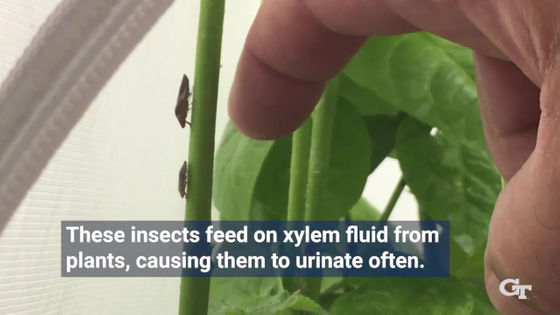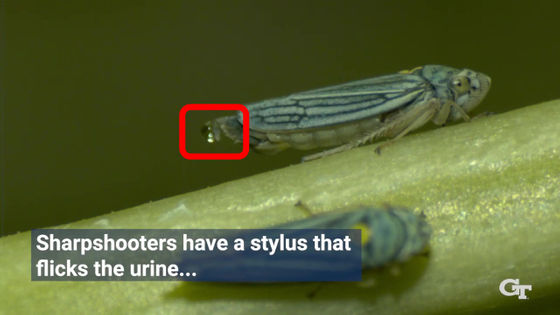You can find a ``super-fast sniper bug'' that injects pee with 10 times the acceleration of a sports car

A paper published in the scientific journal Nature Communications dated February 28, 2023 found that a small insect, only about 1 cm long, has a mechanism to repel urine droplets at high speed using the principle of ``superthrust''. I was. By applying a mechanism that efficiently repels water based on fluid dynamics, it is expected that wearable devices such as smart watches will realize a waterproof function that repels water with the vibration of the speaker.
Droplet superpropulsion in an energetically constrained insect | Nature Communications
Super-fast Insect Urination Powered by the Physics of Superpropulsion |
https://research.gatech.edu/super-fast-insect-urination-powered-physics-superpropulsion
Insect that flings pee with a butt catapult is 1st known example of 'superpropulsion' | Live Science
https://www.livescience.com/insect-that-flings-pee-with-a-butt-catapult-is-1st-known-example-of-superpropulsion-in-nature
Saad Bhamla, an assistant professor in the Department of Chemistry and Biomolecular Engineering at the Georgia Institute of Technology, drew attention to the insect Homalodisca vitripennis, known as the ' glassy-winged sharpshooter. ' It happened when Bhamla was in the backyard. This type of sharpshooter ejected water droplets at such a speed that they seemed to disappear after making water droplets with urine discharged from the tail.
By playing the following movie, you can see how the sideways are skipping urine droplets at high speed.
Super-Fast Insect Urination-YouTube
The two insects perched on the green support are Homalodisca vitripennis, which was the subject of this research. In Japan, it is called Yokobai because it moves sideways when moving with its feet, such as when avoiding a fingertip.

Researchers focused on the speed of urination. To the naked eye, the water droplets on the tail seem to disappear in an instant.

To see what's going on, Bhamla and his team used a high-speed camera and microscope to observe the insect's tail.

As a result, the leafhopper uses a spring-like mechanism, which Bhamla calls a 'butt flicker' and is described in the paper as an 'anal stylus,' to propel droplets like a catapult. I know it's ejected. The stylus can accelerate more than 40G, which is 10 times faster than the fastest sports cars, the researchers said.

Moreover, when the research team measured the speed of the stylus and the droplet, it was found that the droplet was accelerated to 1.4 times the speed at which the stylus moved. The research team believes that this is because the leafhopper uses a mechanism called 'superthrust'.

'Super-thrust' means that the energy is amplified by matching the timing of the compression of an elastic object with the timing of launch, just like a diver in swimming jumps high by gaining momentum with the bending of a board. phenomenon. So far, it has been shown only in artificial systems, and it seems that it has not been confirmed that this principle is used in the natural world.
It's not yet fully understood why leafhoppers urinate so quickly, but the researchers speculate that it may be due to energy efficiency. Leafhoppers feed on plant juice, which is mostly water. The more they drink, the more they produce, but since 99% of the urine of a leafhopper is water, it also needs to be excreted efficiently.
Further observation revealed that the leafhopper uses its stylus to compress droplets and accumulate energy through surface tension. Therefore, the research team dropped a droplet on the audio speaker and performed an experiment to compress the water droplet at high speed by applying vibration. It was confirmed that water droplets can be ejected with

Other insects that feed on sap and the like expel large amounts of water from their tails, but according to the calculations of the research team, the method of repelling water, such as the leafhopper, is a quarter of the method of squirting water. It is said that only about 1 to 1/8 of the energy is required.
The mechanism by which leafhoppers eject water with super-thrust may be applied to products that repel water with low energy. An example would be a smartwatch that repels water using the vibration of a speaker. It may also be used as a power source for

Miriam Ashley Ross of the National Science Foundation, which funded part of the research, said, 'This work may seem strange and esoteric, but it allows us to understand physics on scales that humans cannot normally mimic. It provides insight into the process: The efficient mechanisms evolved by tiny insects could be used to remove solvents from micromanufacturing applications such as electronics, or to quickly remove particles from the surface of complex structures. It may lead to a solution that drains water.'
Related Posts:







